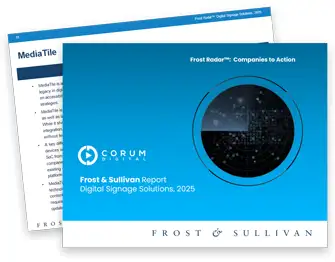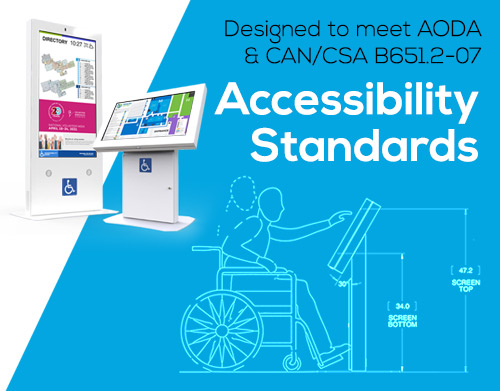7 Steps to a Highly Successful Digital Signage Network
A lot goes into deploying a successful digital signage project
It’s not simply a matter of hanging up screens and showing pictures. Done right, digital signage can be a powerful communication tool that will help you engage, educate and empower your target audience. To get the most out of this technology, there are many things to carefully consider. This blog will describe, at a high level, the steps that need to be taken to roll out a successful digital signage network. In future articles, we'll delve into a little more detail on some of these steps.
There are 7 steps that need to be completed in order for a digital signage network to be successful. They are:

1. Defining Your Goals

2. Selecting a Platform and a Partner

3. Determine your Target Audience

4. How to Engage Your Target Audience

5. Selecting Equipment

6. Determining Locations and Placement

7. Creating Content and Keeping it Fresh

1. Defining Your Goals
Having clearly defined goals gives the project focus and helps keep it on track.
There must be a reason why you're looking at using digital signage. Some requirement that you are trying to find a solution for. It might be to improve the customer experience, improve sales, educate employees on safety and policy changes, help visitors navigate spaces, promote new products and services, the list is endless. Having clearly defined goals gives the project focus and helps keep it on track.

2. Selecting a Partner and a Platform
We intentionally put Partner and Platform together because they go hand in hand.
The most essential part of rolling out a successful digital signage network is choosing the right partner and the right platform to manage your entire network of displays. We intentionally put Partner and Platform together because they go hand in hand. A partner will help guide you through the entire project and beyond. They must have the experience and expertise to implement your communication goals and provide everything needed for a successful roll-out. The digital signage platform consists of network management software and media player software. The network management software manages all the remotely located screens and the content they display, while the media player software controls playback to the screen. The platform not only needs to be easy to use, it needs to be reliable, it needs to have the tools to remotely manage displays, it needs to have all the features to meet your goals and it needs to be well supported. Before you make a decision, make sure you get complete demonstrations of the software and how the back end infrastructure is designed. You want to ensure that the platform you select is one that you will grow into and not out of.

3. Determine your Target Audience
It is critical that you know your target audience.
It is critical that you know your target audience. Are they internal employees? Prospective or existing clients visiting an office environment? Retail shoppers? Patients? Members of the public? Customers waiting to be served? Students? This is just to name a few. Without clearly defining who your target audience is, you can’t adequately determine how best to engage them. Digital Signage is far more effective if it is highly focused rather than simply generic in nature.

4. How to Engage Your Target Audience
Your target audience will determine what is the most impactful method of engagement.
Your target audience will determine what is the most impactful method of engagement. As an example, if you are targeting internal employees, consider strategically placed displays in cafeterias and other gathering places. If you are targeting prospective clients in an office environment, you may want to create somewhat of a wow factor in reception areas with a large video wall. Small tablet sized screens can be placed outside of conference rooms to display daily meeting schedules. For retail shoppers, there are many options to choose from. You will want to consider using high impact video walls, strategically placed displays, interactive kiosks, shelf talkers and touch-enabled tablets to promote products and service and create an engaging customer experience. In public spaces, you can help visitors find their way by displaying interactive wayfinding maps. To make the best decision on how to engage your target audience, you must consider all the various options at your disposal.

5. Selecting Equipment
There are a lot of options when it comes to digital signage equipment.
There are a lot of options when it comes to digital signage equipment. Some of which we mentioned above. The most important part is to ensure you purchase only commercial grade products, with warranties of at least 3 years and consider extending to 5 years. If you want a comparison of consumer vs commercial grade hardware, you can find that in another one of our blogs on this site.

6. Determining Locations and Placement
Displays should be located in places where they will have the most significant impact on your target audience.
Displays should be located in places where they will have the most significant impact on your target audience. This can be more challenging than it first appears. There are a few things to consider here. Consider how much time your audience will have to view your message. Locations with high dwell times are ideal. A hallway may be logistically easy, but will anyone really stand in the hallway to view the display. Also consider the orientation; landscape or portrait. Landscape screens are generally used for informative content, whereas portrait screens are generally used for entertaining content. Finally, consider things like viewing distance and viewing angle. A beautiful 80” display can have minimal impact if it is only a few feet from it’s audience. A blank wall above a hallway make look like the ideal place for a display, but will your audience really be looking 9 or 10 feet in the air at a screen?

7. Creating Content and Keeping it Fresh
One of the most important things to consider is content.
One of the most important things to consider is content. Without content, even the most brilliant 4k display is nothing but a rectangle of dark glass covering a wall. Take the time to consider your audience and how you want to visually communicate with them. Is your goal to engage, inform, educate, empower? Each of these will require vastly different forms of content, some of which may be interactive. Using local news and weather feeds as well as third party content services can help attract eyes and keep content looking fresh. Put together a plan for updating your content regularly. Without it, you will have turned your investment into nothing more than a static sign. Leaving the same old content on a display will quickly get ignored.







